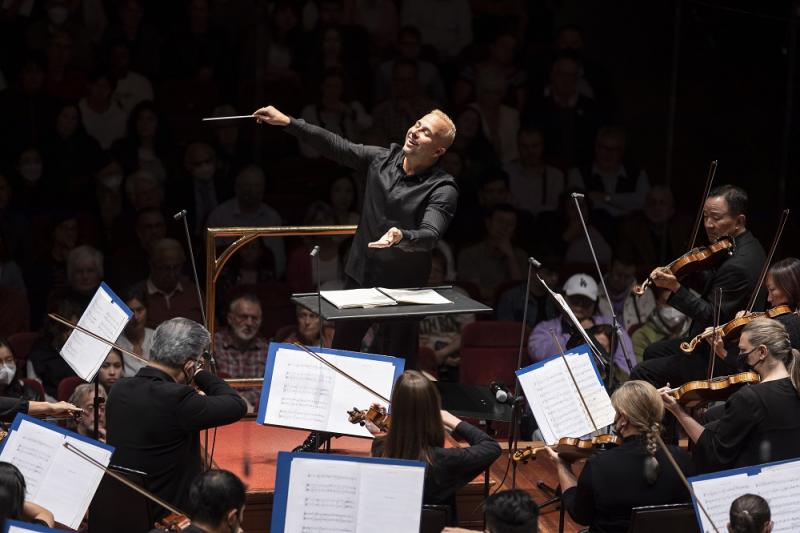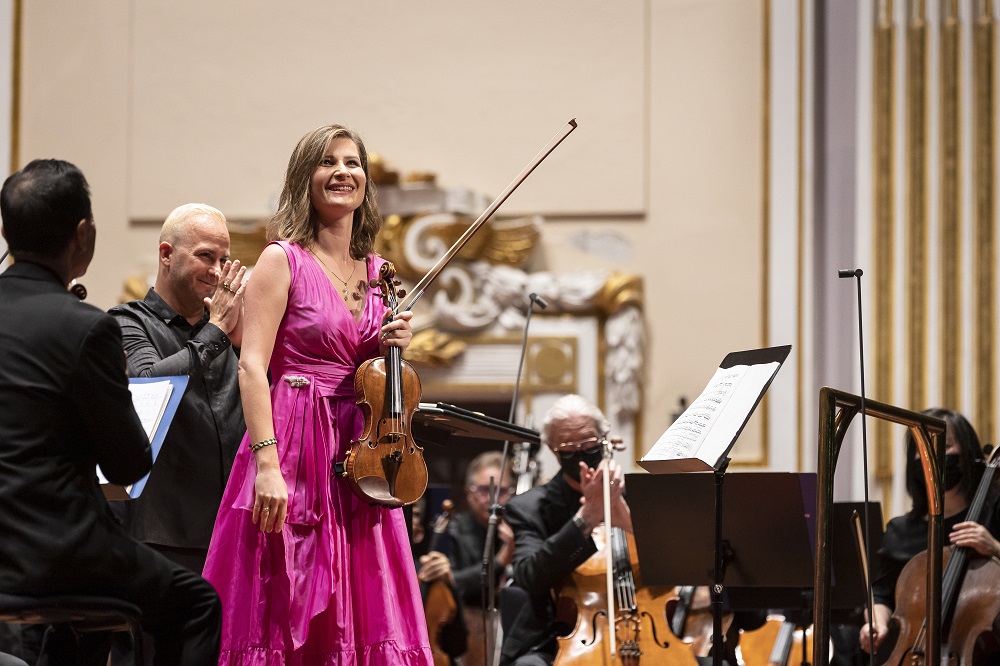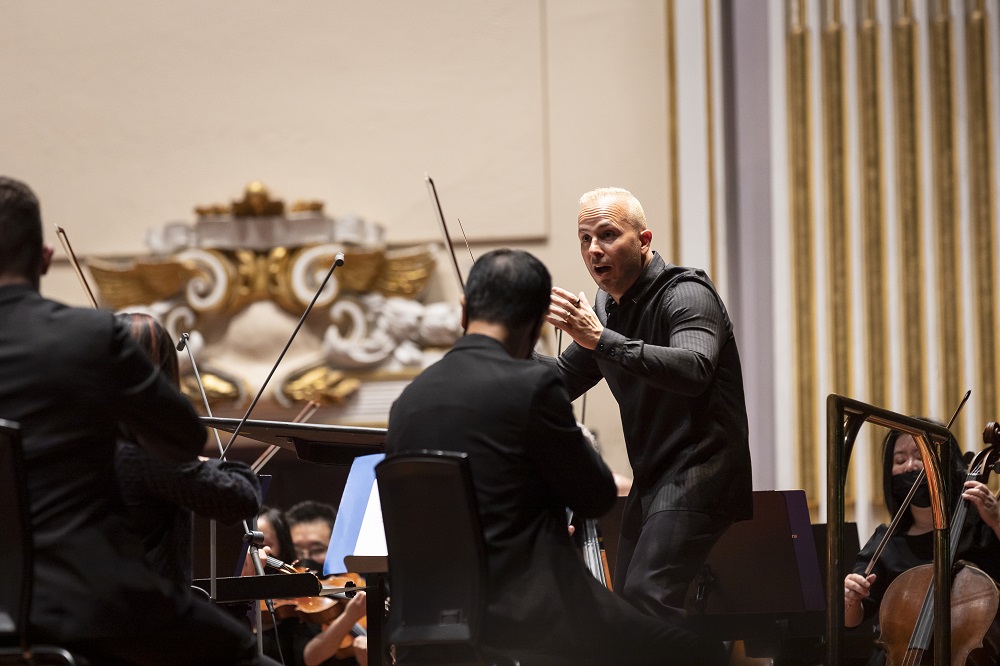Batiashvili, Philadelphia Orchestra, Nézet-Séguin, Edinburgh International Festival 2022 review - classy playing, mismatched programme | reviews, news & interviews
Batiashvili, Philadelphia Orchestra, Nézet-Séguin, Edinburgh International Festival 2022 review - classy playing, mismatched programme
Batiashvili, Philadelphia Orchestra, Nézet-Séguin, Edinburgh International Festival 2022 review - classy playing, mismatched programme
The magic of Karol Szymanowski casts two American composers in the shade

For the penultimate concert in the Philadelphia Orchestra’s residency at the Edinburgh Festival, the chosen repertoire was evidently considered so obscure that the box office managers didn’t even try to sell any tickets in the Usher Hall’s cavernous upper circle. To shut off nearly half the concert hall for a world class orchestra that has crossed the Atlantic shows either a healthy disregard for the fickleness of audience taste, or a near suicidal disinterest in box office revenue.
That, you could say, is what festivals are all about, an approach that might have found some justification in a more focused, albeit uncompromising programme. As it was, we witnessed the folksy populism of Gabriela Lena Frank and Florence Price being seriously outclassed by the European sophistication of Karol Szymanowski.
The concert opened with three movements from Leyendas: An Andean Walkabout by California-born Frank. This was written for string quartet in 2001 and arranged for string orchestra two years later. The programme notes explain how the writing is designed to evoke other instruments, specifically the giant toyo panpipe, the lightweight bamboo quena flute, and the high-pitched guitar-like charango. But a tight-knit body of 45 top class string players sound first and foremost like a string orchestra. True, you could pick out the breathy clicks and open harmonies of the toyo, in particular, from the rich string sound, but these three short pieces conveyed a sense of Andean exoticism comfortably enough without trying to be something else. The real question, though, was why chief conductor Yannick Nézet-Séguin chose to play only three movements of the original six – a decision that smacks of tokenism.  An abrupt change of gear, then, for Szymanowski’s First Violin Concerto, composed in 1916. Dressed in a delicate fuchsia pink, soloist Lisa Batiashvili (pictured above with conductor and players) drifted onto a stage that had filled up reassuringly with piano, celesta, harps, banks of percussion and triple woodwind. This is a concerto of astonishing richness and complexity, a riot of exquisite harmony and piercing orchestration topped by a violin solo that swoops, swoons and slides over the orchestral backcloth with apparent ease. The cerebral introspection of Szymanowski’s kaleidoscopic music is a world apart from Frank’s picturesque Andean walkabout, and we finally heard this fabulous orchestra pushed by Nézet-Séguin to the limits of expression. Batiashvili made the most fiendishly unpredictable music sound relatively straightforward – against a full-blown tutti she never seemed either loud or harsh, but always perfectly audible, even when playing the most delicate harmonics at the upper end of the human audible spectrum. Even she needed a copy of the music to hand for the cadenza, just in case, as Szymanowski wrote a lot of notes, not always in the most comfortable order.
An abrupt change of gear, then, for Szymanowski’s First Violin Concerto, composed in 1916. Dressed in a delicate fuchsia pink, soloist Lisa Batiashvili (pictured above with conductor and players) drifted onto a stage that had filled up reassuringly with piano, celesta, harps, banks of percussion and triple woodwind. This is a concerto of astonishing richness and complexity, a riot of exquisite harmony and piercing orchestration topped by a violin solo that swoops, swoons and slides over the orchestral backcloth with apparent ease. The cerebral introspection of Szymanowski’s kaleidoscopic music is a world apart from Frank’s picturesque Andean walkabout, and we finally heard this fabulous orchestra pushed by Nézet-Séguin to the limits of expression. Batiashvili made the most fiendishly unpredictable music sound relatively straightforward – against a full-blown tutti she never seemed either loud or harsh, but always perfectly audible, even when playing the most delicate harmonics at the upper end of the human audible spectrum. Even she needed a copy of the music to hand for the cadenza, just in case, as Szymanowski wrote a lot of notes, not always in the most comfortable order.
This orchestra has made something of a champion of Florence Price, a composer who fought to overcome the prejudices of race and gender. You could not expect to find a better or more committed performance of her Symphony No. 1, composed in 1932, than that we heard last night, but for all its Dvořákian amiability this is music that frequently sinks to the mundane and the repetitive. There are moments of pure unalloyed joy, such as the famous, and much-extracted, third movement “Juba Dance”, but in the two opening movements the inspiration is thinly spread and the moments of sudden radiance all too often smothered by an inclination to bombast. But clearly the orchestra love this piece, and it was impossible in the end not to share some of their enthusiasm, even the work paled in contrast to what had gone before.  It was a concert of many encores – four to be precise – which were greeted with gradually increasing enthusiasm by a determined audience. A rapid stage reset after the Szymanowski allowed Batiashvili to play a wistful solo accompanied at the piano by Yannick Nézet-Séguin, followed by what sounded like a rumbustious Georgian dance for unaccompanied violin. After the symphony, the orchestra played a wistful string piece called Adoration, also by Florence Price, a gorgeous miniature which sounded as if it had started life as a piano solo. Finally, they dashed off a Brahms Hungarian Dance which was brilliant but only went to demonstrate what a good orchestrator Brahms was when he set his mind to it.
It was a concert of many encores – four to be precise – which were greeted with gradually increasing enthusiasm by a determined audience. A rapid stage reset after the Szymanowski allowed Batiashvili to play a wistful solo accompanied at the piano by Yannick Nézet-Séguin, followed by what sounded like a rumbustious Georgian dance for unaccompanied violin. After the symphony, the orchestra played a wistful string piece called Adoration, also by Florence Price, a gorgeous miniature which sounded as if it had started life as a piano solo. Finally, they dashed off a Brahms Hungarian Dance which was brilliant but only went to demonstrate what a good orchestrator Brahms was when he set his mind to it.
rating
Share this article
Add comment
The future of Arts Journalism
You can stop theartsdesk.com closing!
We urgently need financing to survive. Our fundraising drive has thus far raised £49,000 but we need to reach £100,000 or we will be forced to close. Please contribute here: https://gofund.me/c3f6033d
And if you can forward this information to anyone who might assist, we’d be grateful.

Subscribe to theartsdesk.com
Thank you for continuing to read our work on theartsdesk.com. For unlimited access to every article in its entirety, including our archive of more than 15,000 pieces, we're asking for £5 per month or £40 per year. We feel it's a very good deal, and hope you do too.
To take a subscription now simply click here.
And if you're looking for that extra gift for a friend or family member, why not treat them to a theartsdesk.com gift subscription?
more Classical music
 From Historical to Hip-Hop, Classically Black Music Festival, Kings Place review - a cluster of impressive stars for the future
From quasi-Mozartian elegance to the gritty humour of a kitchen inspection
From Historical to Hip-Hop, Classically Black Music Festival, Kings Place review - a cluster of impressive stars for the future
From quasi-Mozartian elegance to the gritty humour of a kitchen inspection
 Shibe, LSO, Adès, Barbican review - gaudy and glorious new music alongside serene Sibelius
Adès’s passion makes persuasive case for the music he loves, both new and old
Shibe, LSO, Adès, Barbican review - gaudy and glorious new music alongside serene Sibelius
Adès’s passion makes persuasive case for the music he loves, both new and old
 Anja Mittermüller, Richard Fu, Wigmore Hall review - a glorious hall debut
The Austrian mezzo shines - at the age of 22
Anja Mittermüller, Richard Fu, Wigmore Hall review - a glorious hall debut
The Austrian mezzo shines - at the age of 22
 First Person: clarinettist Oliver Pashley on the new horizons of The Hermes Experiment's latest album
Compositions by members of this unusual quartet feature for the first time
First Person: clarinettist Oliver Pashley on the new horizons of The Hermes Experiment's latest album
Compositions by members of this unusual quartet feature for the first time
 Gesualdo Passione, Les Arts Florissants, Amala Dior Company, Barbican review - inspired collaboration excavates the music's humanity
At times it was like watching an anarchic religious procession
Gesualdo Passione, Les Arts Florissants, Amala Dior Company, Barbican review - inspired collaboration excavates the music's humanity
At times it was like watching an anarchic religious procession
 Classical CDs: Camels, concrete and cabaret
An influential American composer's 90th birthday box, plus British piano concertos and a father-and-son duo
Classical CDs: Camels, concrete and cabaret
An influential American composer's 90th birthday box, plus British piano concertos and a father-and-son duo
 Cockerham, Manchester Camerata, Sheen, Martin Harris Centre, Manchester review - re-enacting the dawn of modernism
Two UK premieres added to three miniatures from a seminal event of January 1914
Cockerham, Manchester Camerata, Sheen, Martin Harris Centre, Manchester review - re-enacting the dawn of modernism
Two UK premieres added to three miniatures from a seminal event of January 1914
 Kempf, Brno Philharmonic, Davies, Bridgewater Hall, Manchester review - European tradition meets American jazz
Bouncing Czechs enjoy their Gershwin and Brubeck alongside Janáček and Dvořák
Kempf, Brno Philharmonic, Davies, Bridgewater Hall, Manchester review - European tradition meets American jazz
Bouncing Czechs enjoy their Gershwin and Brubeck alongside Janáček and Dvořák
 Solomon, OAE, Butt, QEH review - daft Biblical whitewashing with great choruses
Even a top soprano and mezzo can’t make this Handel paean wholly convincing
Solomon, OAE, Butt, QEH review - daft Biblical whitewashing with great choruses
Even a top soprano and mezzo can’t make this Handel paean wholly convincing
 Two-Piano Gala, Kings Place review - shining constellations
London Piano Festival curators and illustrious friends entertain and enlighten
Two-Piano Gala, Kings Place review - shining constellations
London Piano Festival curators and illustrious friends entertain and enlighten
 Echo Vocal Ensemble, Latto, Union Chapel review - eclectic choral programme garlanded with dance
Beautiful singing at the heart of an imaginative and stylistically varied concert
Echo Vocal Ensemble, Latto, Union Chapel review - eclectic choral programme garlanded with dance
Beautiful singing at the heart of an imaginative and stylistically varied concert
 Scott, Irish Baroque Orchestra, Whelan, RIAM, Dublin review - towards a Mozart masterpiece
Characteristic joy and enlightenment from this team, but a valveless horn brings problems
Scott, Irish Baroque Orchestra, Whelan, RIAM, Dublin review - towards a Mozart masterpiece
Characteristic joy and enlightenment from this team, but a valveless horn brings problems

Comments
the Upper Circle in the Usher
It's good to have that